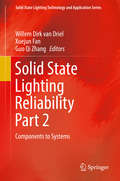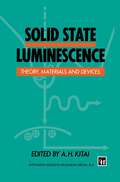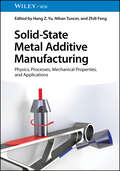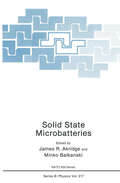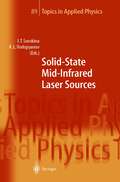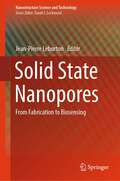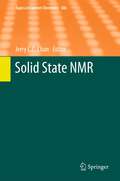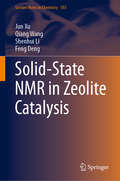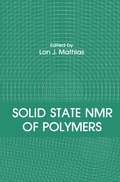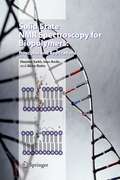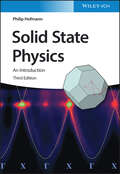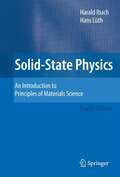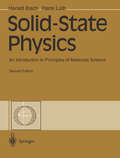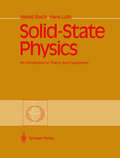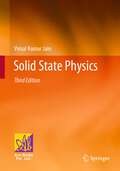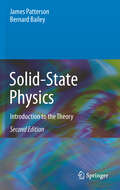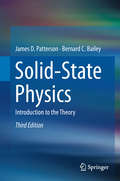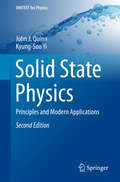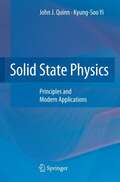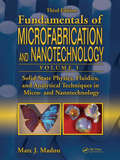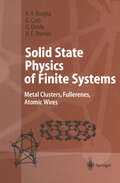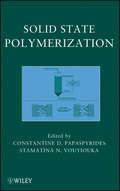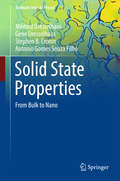- Table View
- List View
Solid State Lighting Reliability Part 2: Components to Systems (Solid State Lighting Technology and Application Series #3)
by Willem Dirk van Driel Xuejun Fan Guo Qi ZhangIn the past four years we have witnessed rapid development in technology and significant market penetration in many applications for LED systems. New processes and new materials have been introduced; new standards and new testing methods have been developed; new driver, control and sensing technologies have been integrated; and new and unknown failure modes have also been presented. In this book, Solid State Lighting Reliability Part 2, we invited the experts from industry and academia to present the latest developments and findings in the LED system reliability arena. Topics in this book cover the early failures and critical steps in LED manufacturing; advances in reliability testing and standards; quality of colour and colour stability; degradation of optical materials and the associated chromaticity maintenance; characterization of thermal interfaces; LED solder joint testing and prediction; common failure modes in LED drivers; root causes for lumen depreciation; corrosion sensitivity of LED packages; reliability management for automotive LEDs, and lightning effects on LEDs.This book is a continuation of Solid State Lighting Reliability: Components to Systems (published in 2013), which covers reliability aspects ranging from the LED to the total luminaire or system of luminaires. Together, these two books are a full set of reference books for Solid State Lighting reliability from the performance of the (sub-) components to the total system, regardless its complexity.
Solid State Luminescence: Theory, materials and devices
by A. H. KitaiHistorically, black body radiation in the tungsten filament lamp was our primary industrial means for producing 'artificial' light, as it replaced gas lamps. Solid state luminescent devices for applications ranging from lamps to displays have proliferated since then, particularly owing to the develop ment of semiconductors and phosphors. Our lighting products are now mostly phosphor based and this 'cold light' is replacing an increasing fraction of tungsten filament lamps. Even light emitting diodes now chal lenge such lamps for automotive brake lights. In the area of information displays, cathode ray tube phosphors have proved themselves to be outstandingly efficient light emitters with excellent colour capability. The current push for flat panel displays is quite intense, and much confusion exists as to where development and commercialization will occur most rapidly, but with the need for colour, it is now apparent that solid state luminescence will play a primary role, as gas phase plasma displays do not conveniently permit colour at the high resolution needed today. The long term challenge to develop electroluminescent displays continues, and high performance fluorescent lamps currently illuminate liquid crystal monochrome and colour displays. The development of tri component rare earth phosphors is of particular importance.
Solid-State Metal Additive Manufacturing: Physics, Processes, Mechanical Properties, and Applications
by Hang Z. Yu Nihan Tuncer Zhili FengSolid-State Metal Additive Manufacturing Timely summary of state-of-the-art solid-state metal 3D printing technologies, focusing on fundamental processing science and industrial applications Solid-State Metal Additive Manufacturing: Physics, Processes, Mechanical Properties, and Applications provides detailed and in-depth discussion on different solid-state metal additive manufacturing processes and applications, presenting associated methods, mechanisms and models, and unique benefits, as well as a detailed comparison to traditional fusion-based metal additive manufacturing. The text begins with a high-level overview of solid-state metal additive manufacturing with an emphasis on its position within the metal additive manufacturing spectrum and its potential for meeting specific demands in the aerospace, automotive, and defense industries. Next, each of the four categories of solid-state additive technologies—cold spray additive manufacturing, additive friction stir deposition, ultrasonic additive manufacturing, and sintering-based processes—is discussed in depth, reviewing advances in processing science, metallurgical science, and innovative applications. Finally, the future directions of these solid-state processes, especially the material innovation and artificial intelligence aspects, are discussed. Sample topics covered in Solid-State Metal Additive Manufacturing include: Physical processes and bonding mechanisms in impact-induced bonding and microstructures and microstructural evolution in cold sprayed materialsProcess fundamentals, dynamic microstructure evolution, and potential industrial applications of additive friction stir depositionMicrostructural and mechanical characterization and industrial applications of ultrasonic additive manufacturingPrinciples of solid-state sintering, binder jetting-based metal printing, and sintering-based metal additive manufacturing methods for magnetic materialsCritical issues inherent to melting and solidification, such as porosity, high residual stress, cast microstructure, anisotropic mechanical properties, and hot cracking Solid-State Metal Additive Manufacturing is an essential reference on the subject for academic researchers in materials science, mechanical, and biomedicine, as well as professional engineers in various manufacturing industries, especially those involved in building new additive technologies.
Solid-State Metal Additive Manufacturing: Physics, Processes, Mechanical Properties, and Applications
by Hang Z. Yu Nihan Tuncer Zhili FengSolid-State Metal Additive Manufacturing Timely summary of state-of-the-art solid-state metal 3D printing technologies, focusing on fundamental processing science and industrial applications Solid-State Metal Additive Manufacturing: Physics, Processes, Mechanical Properties, and Applications provides detailed and in-depth discussion on different solid-state metal additive manufacturing processes and applications, presenting associated methods, mechanisms and models, and unique benefits, as well as a detailed comparison to traditional fusion-based metal additive manufacturing. The text begins with a high-level overview of solid-state metal additive manufacturing with an emphasis on its position within the metal additive manufacturing spectrum and its potential for meeting specific demands in the aerospace, automotive, and defense industries. Next, each of the four categories of solid-state additive technologies—cold spray additive manufacturing, additive friction stir deposition, ultrasonic additive manufacturing, and sintering-based processes—is discussed in depth, reviewing advances in processing science, metallurgical science, and innovative applications. Finally, the future directions of these solid-state processes, especially the material innovation and artificial intelligence aspects, are discussed. Sample topics covered in Solid-State Metal Additive Manufacturing include: Physical processes and bonding mechanisms in impact-induced bonding and microstructures and microstructural evolution in cold sprayed materialsProcess fundamentals, dynamic microstructure evolution, and potential industrial applications of additive friction stir depositionMicrostructural and mechanical characterization and industrial applications of ultrasonic additive manufacturingPrinciples of solid-state sintering, binder jetting-based metal printing, and sintering-based metal additive manufacturing methods for magnetic materialsCritical issues inherent to melting and solidification, such as porosity, high residual stress, cast microstructure, anisotropic mechanical properties, and hot cracking Solid-State Metal Additive Manufacturing is an essential reference on the subject for academic researchers in materials science, mechanical, and biomedicine, as well as professional engineers in various manufacturing industries, especially those involved in building new additive technologies.
Solid State Microbatteries (Nato Science Series B: #217)
by James R. Akridge M. BalkanskiThis Advanced Study Institute on the topic of SOLID STATE MICROBATTERIES is the third and final institute on the general theme of a field of study now termed "SOLID STATE IONICS". The institute was held in Erice, Sicily, Italy, 3 - 15 July 1988. The objective was to assemble in one location individuals from industry and academia expert in the fields of microelectronics and solid state ionics to determine the feasibility of merging a solid state microbattery with microelectronic memory. Solid electrolytes are in principle amenable to vapor deposition, RF or DC sputtering, and other techniques used to fabricate microelectronic components. A solid state microbattery 1 1 mated on the same chip carrier as the chip can provide on board memory backup power. A solid state microbattery assembled from properly selected anode/solid electrolyte/cathode materials could have environmental endurance properties equal or superior to semiconductor memory chips. Lectures covering microelectronics, present state-of-art solid state batteries, new solid electrolyte cathode materials, theoretical and practical techniques for fabrication of new solid electrolytes, and analytical techniques for study of solid electrolytes were covered. Several areas where effort is required for further understanding of materials in pure form and their interactions with other materials at interfacial contact points were identified. Cathode materials for solid state batteries is one particular research area which requires attention. Another is a microscopic model of conduction in vitreous solid electrolytes to enhance the thermodynamic macroscopic Weak ~lectrolyte Iheory (WET).
Solid-State Mid-Infrared Laser Sources (Topics in Applied Physics #89)
by Irina T. Sorokina Konstantin L. VodopyanovThis collection of authoritative reviews by leading experts provides a broad and instructive introduction to the most advanced techniques for generating coherent light in the mid-infrared region of the spectrum. With a wealth of up-to-date references – also available online.
Solid State Nanopores: From Fabrication to Biosensing (Nanostructure Science and Technology)
by Jean-Pierre LeburtonThis contributed volume provides an overview of the recent advances in solid-state nanopore technology, featuring contributions by leading experts in the field. It discusses several aspects of solid-state nanopores, covering their fabrication as well as multiple biosensing applications. It successfully bridges the gap between various scientific and engineering disciplines and highlights the progress made in this area. This title is a useful tool for acquiring basic knowledge of this field and following recent progress. It is a valuable contribution to the area of nanopore biosensing and is of interest to graduate students, postdocs, or senior researchers working in the fields of physical chemistry, biochemistry, bio- and electrical engineering, and biophysics.
Solid State NMR (Topics in Current Chemistry #306)
by Jerry C. C. ChanDipolar Recoupling, by Niels Chr. Nielsen, Lasse A. Strassø and Anders B. Nielsen.-Solid-State NMR Techniques for the Structural Determination of Amyloid Fibrils, by Jerry C. C. Chan.-Solid-State 19F-NMR of Peptides in Native Membranes, by Katja Koch, Sergii Afonin, Marco Ieronimo, Marina Berditsch and Anne S. Ulrich.-Probing Quadrupolar Nuclei by Solid-State NMR Spectroscopy: Recent Advances, by Christian Fernandez and Marek Pruski.-Solid State NMR of Porous Materials Zeolites and Related Materials, by Hubert Koller and Mark Weiß.-Solid-State NMR of Inorganic Semiconductors, by James P. Yesinowski.-
Solid-State NMR in Zeolite Catalysis (Lecture Notes in Chemistry #103)
by Jun Xu Qiang Wang Shenhui Li Feng DengSolid-State NMR Characterization of Heterogeneous Catalysts and Catalytic Reactions provides a comprehensive account of state-of-the-art solid-state NMR techniques and the application of these techniques in heterogeneous catalysts and related catalytic reactions. It includes an introduction to the basic theory of solid-state NMR and various frequently used techniques. Special emphasis is placed on characterizing the framework and pore structure, active site, guest-host interaction, and synthesis mechanisms of heterogeneous catalysts using multinuclear one- and two-dimensional solid-sate NMR spectroscopy. Additionally, various in-situ solid-state NMR techniques and their applications in investigation of the mechanism of industrially important catalytic reactions are also discussed. Both the fundamentals and the latest research results are covered, making the book suitable as a reference guide for both experienced researchers in and newcomers to this field.Feng Deng is a Professor at Wuhan Institute of Physics and Mathematics, Chinese Academy of Sciences.
Solid State NMR of Polymers
by L. J. MathiasThe chapters in this collection are from papers which were presented at a symposium on solid-state NMR of polymers. A two-part program on available NMR techniques applicable to solid polymer analysis was presented at the 3rd Chemical Congress of North American held in Toronto, Ontario, June 5-10,1988. The program was sponsored by the Division of Polymer Chemistry with support provided by the Division, its Industrial Sponsors, and the Donors of the Petroleum Research Fund administered by the American Chemical Society. Co-organizers included Professor Colin Fyfe of the University of British Columbia (Vancouver, Canada), Professor Hans Spiess of the Max Planck Institut fur Polymerforschung (Mainz, West Germany), and myself. The full-day tutorial, which was free to registered attendees, covered the range of topics. The purpose of the tutorial was to provide a basic introduction to the field so that newcomers to its present and future applications could develop sufficient understanding to learn effectively from the subsequent symposium. The first talk attempted to give listeners a feel for the way a novice spectroscopist can learn to use the various NMR techniques to explore his own areas of interest. Simple experiments can provide unique information about solid polymers that can be useful in interpreting synthetic results and in relating solid-state conformation, morphology and molecular motion to physical properties.
Solid State NMR Spectroscopy for Biopolymers: Principles and Applications
by Hazime Saitô Isao Ando Akira Naito‘‘Biopolymers’’ are polymeric materials of biological origin, including globular, membrane, and fibrous proteins, polypeptides, nucleic acids, po- saccharides, lipids, etc. and their assembly, although preference to respe- ive subjects may be different among readers who are more interested in their biological significance or industrial and/or medical applications. Nevert- less, characterizing or revealing their secondary structure and dynamics may be an equally very important and useful issue for both kinds of readers. Special interest in revealing the 3D structure of globular proteins, nucleic acids, and peptides was aroused in relation to the currently active Structural Biology. X-ray crystallography and multidimensional solution NMR sp- troscopy have proved to be the standard and indispensable means for this purpose. There remain, however, several limitations to this end, if one intends to expand its scope further. This is because these approaches are not always straightforward to characterize fibrous or membrane proteins owing to extreme difficulty in crystallization in the former, and insufficient spectral resolution due to sparing solubility or increased effective molecular mass in the presence of surrounding lipid bilayers in the latter.
Solid State Physics: An Introduction
by Philip HofmannEnables readers to easily understand the basics of solid state physics Solid State Physics is a successful short textbook that gives a clear and concise introduction to its subject. The presentation is suitable for students who are exposed to this topic for the first time. Each chapter starts with basic principles and gently progresses to more advanced concepts, using easy-to-follow explanations and keeping mathematical formalism to a minimum. This new edition is thoroughly revised, with easier-to-understand descriptions of metallic and covalent bonding, a straightforward proof of Bloch's theorem, a simpler approach to the nearly free electron model, and enhanced pedagogical features, such as more than 100 discussion questions, 70 problems--including problems to train the students’ skills to find computational solutions--and multiple-choice questions at the end of each chapter, with solutions in the book for self-training. Solid State Physics introduces the readers to: Crystal structures and underlying bonding mechanisms The mechanical and vibrational properties of solids Electronic properties in both a classical and a quantum mechanical picture, with a treatment of the electronic phenomena in metals, semiconductors and insulators More advanced subjects, such as magnetism, superconductivity and phenomena emerging for nano-scaled solidsFor bachelor’s students in physics, materials sciences, engineering sciences, and chemistry, Solid State Physics serves as an introductory textbook, with many helpful supplementary learning resources included throughout the text and available online, to aid in reader comprehension.
Solid State Physics: An Introduction
by Philip HofmannEnables readers to easily understand the basics of solid state physics Solid State Physics is a successful short textbook that gives a clear and concise introduction to its subject. The presentation is suitable for students who are exposed to this topic for the first time. Each chapter starts with basic principles and gently progresses to more advanced concepts, using easy-to-follow explanations and keeping mathematical formalism to a minimum. This new edition is thoroughly revised, with easier-to-understand descriptions of metallic and covalent bonding, a straightforward proof of Bloch's theorem, a simpler approach to the nearly free electron model, and enhanced pedagogical features, such as more than 100 discussion questions, 70 problems--including problems to train the students’ skills to find computational solutions--and multiple-choice questions at the end of each chapter, with solutions in the book for self-training. Solid State Physics introduces the readers to: Crystal structures and underlying bonding mechanisms The mechanical and vibrational properties of solids Electronic properties in both a classical and a quantum mechanical picture, with a treatment of the electronic phenomena in metals, semiconductors and insulators More advanced subjects, such as magnetism, superconductivity and phenomena emerging for nano-scaled solidsFor bachelor’s students in physics, materials sciences, engineering sciences, and chemistry, Solid State Physics serves as an introductory textbook, with many helpful supplementary learning resources included throughout the text and available online, to aid in reader comprehension.
Solid-State Physics: An Introduction to Principles of Materials Science
by Harald Ibach Hans LüthThis new edition of the well-received introduction to solid-state physics provides a comprehensive overview of the basic theoretical and experimental concepts of materials science. Experimental aspects and laboratory details are highlighted in separate panels that enrich text and emphasize recent developments. Notably, new material in the third edition includes sections on important new devices, aspects of non- periodic structures of matter, phase transitions, defects, superconductors and nanostructures. Students will benefit significantly from solving the exercises given at the end of each chapter. This book is intended for university students in physics, materials science and electrical engineering. It has been thoroughly updated to maintain its relevance and usefulness to students and professionals.
Solid-State Physics: An Introduction to Principles of Materials Science
by Harald Ibach Hans LüthOur German textbook "Festkdrperphysik" has become rather pop ular among German-speaking students, and is currently produced in its 4th edition. Its version in English has already been adopted by many universities in the United States and other countries. This new 2nd edition corresponds to the 4th edition in German. In addition to correcting some typographical errors and making small improvements in the presentation, in the present edition some chapters have been revised or extended. Panel V, for example, has been extended to include a description of angle-resolved photoemis sion and its importance for the study of electronic band structures. Section 10.10 on high-temperature superconductors has completely been rewritten. This active field of research continues to progress rapidly and many new results have emerged since the publication of the first edition. These results shed new light on much of the fun damental physics. The new version of Sect. 10.10 has been developed in discussions with colleagues who are themselves engaged in superconductivity research. We thank, in particular, Professor C. Calandra from the University of Modena and Dr. R. Wordenweber of the Institute of Thin Film and Ion Technology at the Research Centre Jiilich. The revision of the problems was done with the help of Dr. W.
Solid-State Physics: An Introduction to Theory and Experiment
by Harald Ibach Hans LüthIn recent decades solid state physics has seen many dramatic new developments and has become one of the largest independent branches of physics. It has simultaneously ex panded into many new areas, playing a vital role in fields that were once the domain of the engineering and chemical sciences. A consequence of this explosive development is that no single university lecturer can today be expected to have a detailed knowledge of all aspects of this vast subject; likewise, it is impossible to conceive of a course that could offer students a comprehensive understanding of the entire discipline and its many applications. In view of this situation, it is particularly valuable to have a textbook that gives a concise account of the essential elements of the physics of solids. In this book the fun damental aspects of solid state physics are presented according to the scheme: Chemical bonding, structure, lattice dynamics, and electronic properties. We believe that this se quence is the optimum choice for tutorial purposes. It enables the more difficult con cepts to be introduced at a point where a basic understanding of fundamental ideas has already been achieved through the study of simple models and examples. In addition to this carefully structured exposition of classical solid state theory based on the periodic solid and the one-electron approximation, the book also includes comprehen sive descriptions of the most active areas in modern research: Magnetism, superconduc tivity and semiconductor physics.
Solid State Physics
by Vimal Kumar JainThe book has been designed as a textbook for graduate and postgraduate students of physics, material science, and engineering. This is the third edition of the textbook, that is updated to reflect recent works in the field. In this edition, some new topics have been introduced while some of the existing topics like phonons, Drude –Lorentz model, Fermi levels, electrons, and holes, etc. are modified. Moreover, the book has complete information on semiconductor devices like tunnel diode, Gunn diode, photodiode, photoconductive diode, varactor diode, solar cell, LED, semiconductor lasers, and semiconductor detectors. All the chapters have been supplemented by solved and unsolved examples. Some of the chapters illustrate areas of current interest in solid-state physics to give the student practical working knowledge of the subject text in a simple and lucid manner. There is a fair amount of detail in the examples and derivations given in the text. Each section of the book has exercises to reinforce the concepts, and problems have been added at the end of each chapter. The detailed coverage and pedagogical tools make this an ideal textbook for students and researchers enrolled in graduate and postgraduate courses of physics, material science, and engineering.
Solid-State Physics: Introduction to the Theory
by James Patterson Bernard BaileyWhile the standard solid state topics are covered, the basic ones often have more detailed derivations than is customary (with an empasis on crystalline solids). Several recent topics are introduced, as are some subjects normally included only in condensed matter physics. Lattice vibrations, electrons, interactions, and spin effects (mostly in magnetism) are discussed the most comprehensively. Many problems are included whose level is from "fill in the steps" to long and challenging, and the text is equipped with references and several comments about experiments with figures and tables.
Solid-State Physics: Introduction to the Theory
by James D. Patterson Bernard C. BaileyWhile the standard solid state topics are covered, the basic ones often have more detailed derivations than is customary (with an empasis on crystalline solids). Several recent topics are introduced, as are some subjects normally included only in condensed matter physics. Lattice vibrations, electrons, interactions, and spin effects (mostly in magnetism) are discussed the most comprehensively. Many problems are included whose level is from "fill in the steps" to long and challenging, and the text is equipped with references and several comments about experiments with figures and tables.
Solid State Physics: Principles and Modern Applications (UNITEXT for Physics)
by John J. Quinn Kyung-Soo YiThis book provides the basis for a two-semester graduate course on solid-state physics. The first half presents all the knowledge necessary for a one-semester survey of solid-state physics, but in greater depth than most introductory solid state physics courses. The second half includes most of the important research over the past half-century, covering both the fundamental principles and most recent advances. This new edition includes the latest developments in the treatment of strongly interacting two-dimensional electrons and discusses the generalization from small to larger systems.The book provides explanations in a class-tested tutorial style, and each chapter includes problems reviewing key concepts and calculations. The updated exercises and solutions enable students to become familiar with contemporary research activities, such as the electronic properties of massless fermions in graphene and topological insulators.
Solid State Physics: Principles and Modern Applications
by John J. Quinn Kyung-Soo YiIntended for a two semester advanced undergraduate or graduate course in Solid State Physics, this treatment offers modern coverage of the theory and related experiments, including the group theoretical approach to band structures, Moessbauer recoil free fraction, semi-classical electron theory, magnetoconductivity, electron self-energy and Landau theory of Fermi liquid, and both quantum and fractional quantum Hall effects. Integrated throughout are developments from the newest semiconductor devices, e.g. space charge layers, quantum wells and superlattices. The first half includes all material usually covered in the introductory course, but in greater depth than most introductory textbooks. The second half includes most of the important developments in solid-state researches of the past half century, addressing e.g. optical and electronic properties such as collective bulk and surface modes and spectral function of a quasiparticle, which is a basic concept for understanding LEED intensities, X ray fine structure spectroscopy and photoemission. So both the fundamental principles and most recent advances in solid state physics are explained in a class-tested tutorial style, with end-of-chapter exercises for review and reinforcement of key concepts and calculations.
Solid-State Physics, Fluidics, and Analytical Techniques in Micro- and Nanotechnology
by Marc J. MadouProviding a clear theoretical understanding of MEMS and NEMS, Solid-State Physics, Fluidics, and Analytical Techniques in Micro- and Nanotechnology focuses on nanotechnology and the science behind it, including solid-state physics. It provides a clear understanding of the electronic, mechanical, and optical properties of solids relied on in integra
Solid State Physics of Finite Systems: Metal Clusters, Fullerenes, Atomic Wires (Advanced Texts in Physics)
by R.A. Broglia G. Coló G. Onida H.E. RomanQuantum mechanics is the set of laws of physics which, to the best of our knowledge, provides a complete account of the microworld. One of its chap ters, quantum electrodynamics (QED), is able to account for the quantal phenomena of relevance to daily life (electricity, light, liquids and solids, etc.) with great accuracy. The language of QED, field theory, has proved to be uni versal providing the theoretical basis to describe the behaviour of many-body systems. In particular finite many-body systems (FMBS) like atomic nuclei, metal clusters, fullerenes, atomic wires, etc. That is, systems made out of a small number of components. The properties of FMBS are expected to be quite different from those of bulk matter, being strongly conditioned by quantal size effects and by the dynamical properties of the surface of these systems. The study of the elec tronic and of the collective behaviour (plasmons and phonons) of FMBS and of their interweaving, making use of well established first principle quantum (field theoretical) techniques, is the main subject of the present monograph. The interest for the study of FMBS was clearly stated by Feynman in his address to the American Physical Society with the title "There is plenty of room at the bottom". On this occasion he said among other things: "When we get to the very, very small world - say circuits of seven atoms - we have a lot of new things that would happen that represent completely new opportunities for design" [1].
Solid State Polymerization
by Constantine D. Papaspyrides Stamatina N. VouyioukaThe most current guide to solid state polymerization Solid State Polymerization (SSP)is an indispensable tool in the design, manufacture, and study of polymers, plastics, and fibers. SSP presents significant advantages over other polymerization techniques due to low operating temperatures, inexpensive equipment, and simple and environmentally sound procedures. Combining fundamentals of polymer science, chemistry, physical chemistry, and engineering, SSP also offers many research applications for a wide range of students and investigators. Gathering and filtering the latest literature on SSP, Solid Solid State Polymerization offers a unique, one-stop resource on this important process. With chapters contributed by leaders in the field, this text summarizes SSP, and provides essential coverage that includes: An introduction to SSP, with chemical and physical steps, apparatus, advantages, and parameters SSP physical chemistry and mechanisms Kinetic aspects of polyesters and polyamides SSP Catalysis in SSP processes Application of SSP under high pressure conditions in the laboratory Engineering aspects regarding process modeling and industrial application Recent developments and future possibilities Solid State Polymerization provides the most up-to-date coverage of this constantly developing field to academic and industry professionals, as well as graduate and postgraduate-level students in chemical engineering, materials science and engineering, polymer chemistry, polymer processing and polymer engineering.
Solid State Properties: From Bulk to Nano (Graduate Texts in Physics)
by Mildred Dresselhaus Gene Dresselhaus Stephen B. Cronin Antonio Gomes Souza FilhoThis book fills a gap between many of the basic solid state physics and materials sciencebooks that are currently available. It is written for a mixed audience of electricalengineering and applied physics students who have some knowledge of elementaryundergraduate quantum mechanics and statistical mechanics. This book, based on asuccessful course taught at MIT, is divided pedagogically into three parts: (I) ElectronicStructure, (II) Transport Properties, and (III) Optical Properties. Each topic is explainedin the context of bulk materials and then extended to low-dimensional materials whereapplicable. Problem sets review the content of each chapter to help students to understandthe material described in each of the chapters more deeply and to prepare them to masterthe next chapters.
